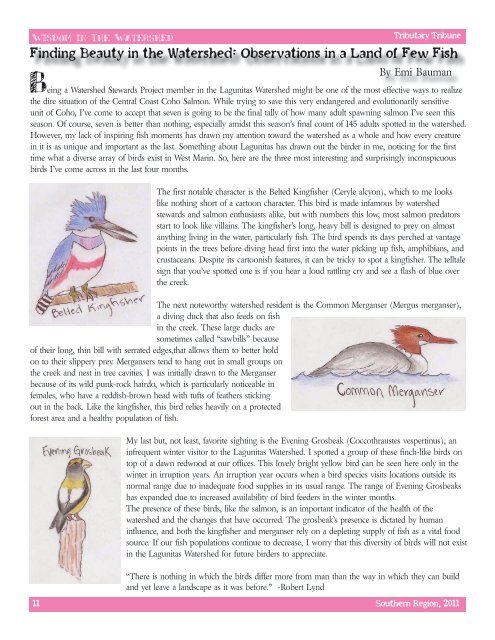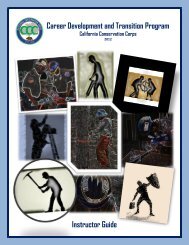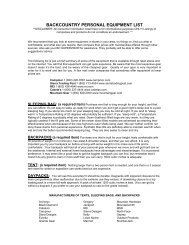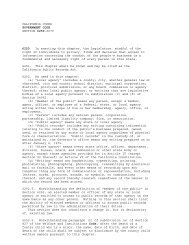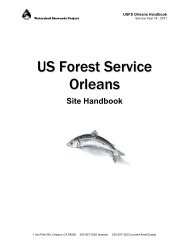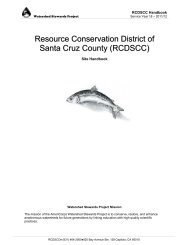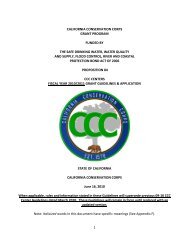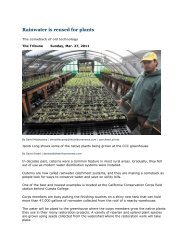Tributary Tribune - California Conservation Corps
Tributary Tribune - California Conservation Corps
Tributary Tribune - California Conservation Corps
Create successful ePaper yourself
Turn your PDF publications into a flip-book with our unique Google optimized e-Paper software.
Wisdom in The Watershed<br />
<strong>Tributary</strong> <strong>Tribune</strong><br />
Finding Beauty in the Watershed: Observations in a Land of Few Fish<br />
By Emi Bauman<br />
Being a Watershed Stewards Project member in the Lagunitas Watershed might be one of the most effective ways to realize<br />
the dire situation of the Central Coast Coho Salmon. While trying to save this very endangered and evolutionarily sensitive<br />
unit of Coho, I’ve come to accept that seven is going to be the final tally of how many adult spawning salmon I’ve seen this<br />
season. Of course, seven is better than nothing, especially amidst this season’s final count of 145 adults spotted in the watershed.<br />
However, my lack of inspiring fish moments has drawn my attention toward the watershed as a whole and how every creature<br />
in it is as unique and important as the last. Something about Lagunitas has drawn out the birder in me, noticing for the first<br />
time what a diverse array of birds exist in West Marin. So, here are the three most interesting and surprisingly inconspicuous<br />
birds I’ve come across in the last four months.<br />
The first notable character is the Belted Kingfisher (Ceryle alcyon), which to me looks<br />
like nothing short of a cartoon character. This bird is made infamous by watershed<br />
stewards and salmon enthusiasts alike, but with numbers this low, most salmon predators<br />
start to look like villains. The kingfisher’s long, heavy bill is designed to prey on almost<br />
anything living in the water, particularly fish. The bird spends its days perched at vantage<br />
points in the trees before diving head first into the water picking up fish, amphibians, and<br />
crustaceans. Despite its cartoonish features, it can be tricky to spot a kingfisher. The telltale<br />
sign that you’ve spotted one is if you hear a loud rattling cry and see a flash of blue over<br />
the creek.<br />
The next noteworthy watershed resident is the Common Merganser (Mergus merganser),<br />
a diving duck that also feeds on fish<br />
in the creek. These large ducks are<br />
sometimes called “sawbills” because<br />
of their long, thin bill with serrated edges,that allows them to better hold<br />
on to their slippery prey. Mergansers tend to hang out in small groups on<br />
the creek and nest in tree cavities. I was initially drawn to the Merganser<br />
because of its wild punk-rock hairdo, which is particularly noticeable in<br />
females, who have a reddish-brown head with tufts of feathers sticking<br />
out in the back. Like the kingfisher, this bird relies heavily on a protected<br />
forest area and a healthy population of fish.<br />
My last but, not least, favorite sighting is the Evening Grosbeak (Coccothraustes vespertinus), an<br />
infrequent winter visitor to the Lagunitas Watershed. I spotted a group of these finch-like birds on<br />
top of a dawn redwood at our offices. This lovely bright yellow bird can be seen here only in the<br />
winter in irruption years. An irruption year occurs when a bird species visits locations outside its<br />
normal range due to inadequate food supplies in its usual range. The range of Evening Grosbeaks<br />
has expanded due to increased availability of bird feeders in the winter months.<br />
The presence of these birds, like the salmon, is an important indicator of the health of the<br />
watershed and the changes that have occurred. The grosbeak’s presence is dictated by human<br />
influence, and both the kingfisher and merganser rely on a depleting supply of fish as a vital food<br />
source. If our fish populations continue to decrease, I worry that this diversity of birds will not exist<br />
in the Lagunitas Watershed for future birders to appreciate.<br />
“There is nothing in which the birds differ more from man than the way in which they can build<br />
and yet leave a landscape as it was before.” -Robert Lynd<br />
11 Southern Region, 2011


